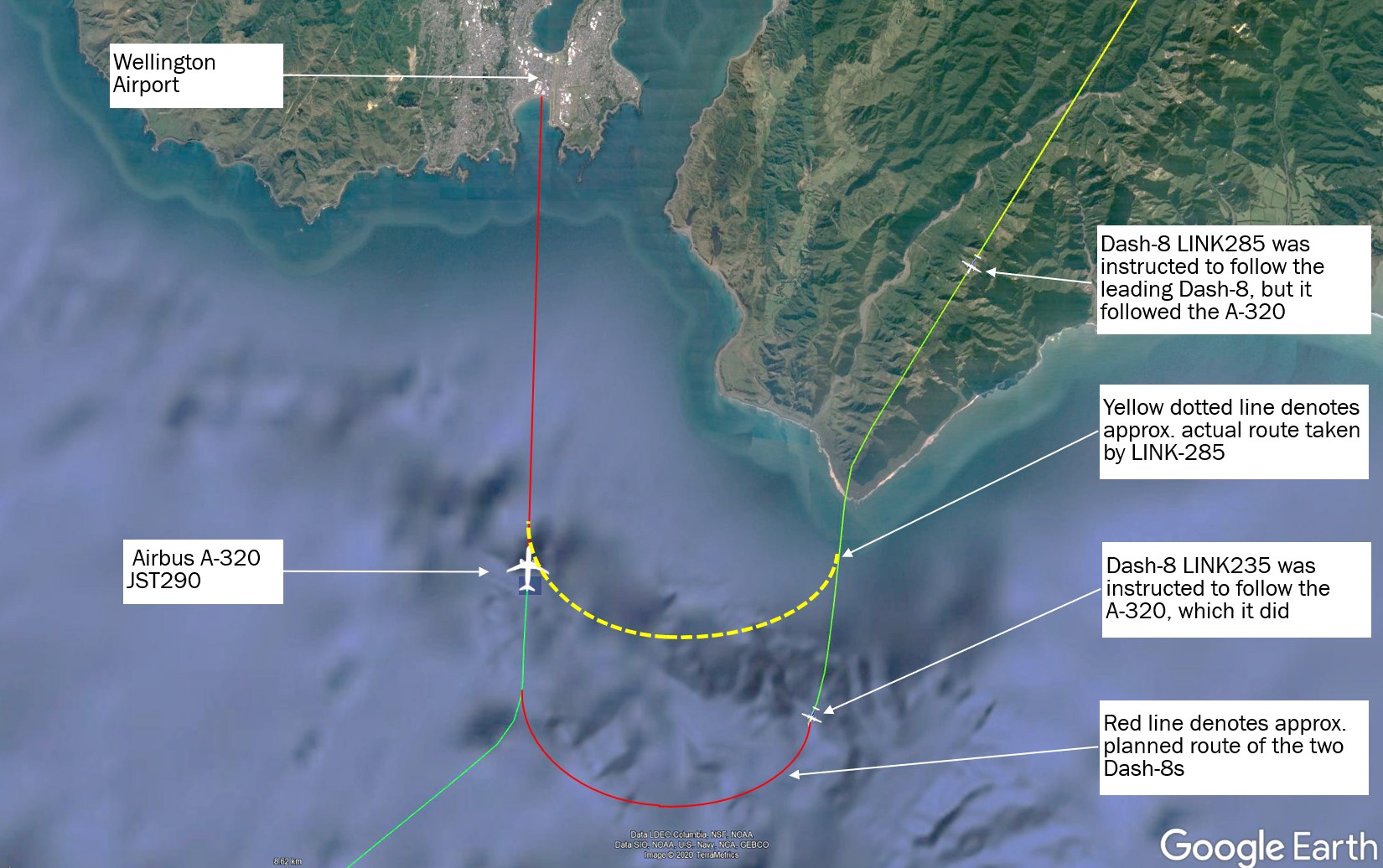
In Brief: Two Dash-8s avoided collision on approach to Wellington Airport (saved by human and automated systems) after one Dash-8 followed the wrong lead aircraft. Nobody hurt, no damage. All safety issues are resolved, so no new TAIC recommendations.
What happened
Three aeroplanes: Three aeroplanes on scheduled passenger flights were sequenced to land at Wellington Airport [see diagram], approaching in this order:
- A320 (JST-290) approaching from the south-west
- Dash-8 (LINK-235) joining from the north-east
- Dash-8 (LINK-285) also joining from the north-east, 2 minutes behind LINK-235
Two Dash-8s chose visual approach: The crews of the two Dash-8s requested and received permission from the (Christchurch-located) approach controller to make a visual approach to land. The approach controller instructed LINK-235 to follow the A-320 and LINK-285 to follow LINK-235.
Dash-8s on conflicting course: LINK-285 had two planes ahead of it. It misidentified the A320 as the Dash-8, and turned to follow the A-320. This put LINK-285 into a conflicting flight path with LINK-235, too close to LINK-235. An automatic short-term conflict alert warning alerted air traffic controllers that the two Dash-8s might collide.
Collision prevented:
- The Christchurch-based approach controller was unable to reach LINK-285 via radio because LINK-285 had already switched radio channel to Wellington Tower. However, Wellington Tower was under the impression that Approach Control was still responsible for LINK-285 so said nothing to LINK-285.
- In quick succession: the approach controller telephoned the Wellington tower; Wellington air traffic control broadcasted a radio warning; the Dash-8s saw each other and took evasive action; and seconds later the onboard traffic-collision-avoidance systems of both Dash-8s called for evasive action.
- All three aeroplanes landed without further incident.
Why it happened
- Situational awareness: LINK-285’s flight crew had not absorbed all available information to correctly identify which aeroplane was ahead of them. Light and other visual conditions made the task harder, and didn’t use other means to double-check their perceptions.
- Collision avoidance fail-safes: Automatic and human defenses in air traffic control and aircraft systems detected the potential conflict and prevented a collision.
Safety Issues
The Commission found three safety issues: Two concerned procedures for a flight shifting from instrument flight rules to a visual approach to land, and one concerning protection of cockpit voice recordings after an incident:
- Situational awareness: Critical information for a flight crew to conduct a visual approach was not required to be passed on to the flight crew.
- Collision avoidance: Air traffic control procedures could create a situation where an approach controller would be unable to contact a flight crew when the controller was still responsible for monitoring that flight crew’s compliance with an instruction.
- Cockpit voice recordings lost: cockpit voice recordings on the two Dash-8s were left running and were thus overwritten, recording over the flight crew conversations during the flights. This mean potentially critical evidence from a serious incident was lost. At the time, the operator’s guidelines did not prevent this happening.
Following the incident, all operators concerned adequately addressed these safety issues, so there is no need for the Commission to make new safety recommendations.
Key lessons
- Pilots should use all available resources to build situational awareness.
- When a controller issues a clearance, it is important to monitor the flight crew’s initial compliance to check it has been interpreted as intended.
- Flight crews can improve their situational awareness and avoid mid-air collisions by paying attention to the instrument display for the Traffic Collision Avoidance System.
